Bandon Dunes
OR, USA
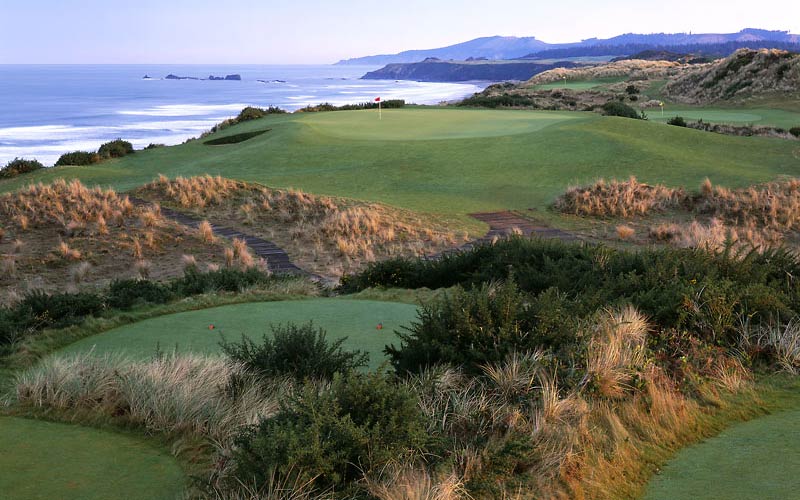
With six greens perched along the Oregon shoreline, Bandon Dunes was an immediate hit with golfers. Pictured is the green to the one shot sixth hole.
Bandon Dunes is synonymous today with the world’s best golf resort. The original course is now complimented by two additional courses (with a fourth on the way), but it remains the impetus for the resort’s immense popularity. Given the strength of the subsequent courses at the resort, Bandon has faded only slightly from its initially lofty status, a testament to its original underlying quality. Golf architects rarely produce their best work in their first course for several reasons. One reason is obviously inexperiencebut just as importantly, they alsohave yet to establish aconstruction crew that knows how to best translate their ideas into the dirt.Although David McLay Kidd understood the strategy of golf architecture, the finishing details at Bandon Dunes pale relative to those of its sister courses, Pacific Dunes and Bandon Trails. These later two courses benefited immeasurably from the veteran team that designed and built the respective courses. DoesBandon Dunes stand up to scrutiny in the way that Pebble Beach and Cypress Point have for decades? No. However, it certainly stands toe-to-toe – and then some – with many heralded modern courses such as Spyglass Hill and Kauri Cliffs. Bandon is a special place, largely due to the fact that it enjoysas romantic a settingas any course built since World War II. Yet most people who play here struggle for specific comments onits designaspects. They justly rave about the setting of the course,the firm and fast playing conditions that Green Keeper Troy Russell and his staff present, the understated clubhouse and its cozy cabins. While these factors enhance the overall ambience and experience, they also mask a very good, but not great, design. One of the design’s chief attributes is that Bandon Dunes remains imminently playable in even the fiercest of winds. The fairways are quite generous and the greens huge, althoughboth unnecessarily so in spots. However, this concept works well even in calm conditions as the reasonable and interesting undulations of the greens present a challenge in terms of negotiating 50 feet with two putts. Bandon’s design weakness lies in its finishing touches, which are sometimes not fully and compellingly integrated together. The scenic sixth hole, for example, is quite demanding, but largely due to the awkwardness ofitsraised green complex, which negates the opportunity to hit a low running shotunder the prevailing summer winds. One great course that Bandon Dunes doesshare broad similarities with is Royal Portrush. The owner Mike Keiser has long enjoyed playing links golf in the United Kingdom and Portrush is a course he admires. Similar to Harry Colt’s masterpiece, the 4th and 5th at Bandon are the course’s most compelling two shot holes and are followed by a tough one shotter,both ninesloop to the cliff’s edge, there is a general paucity of greenside bunkering, the golfer is given a chance in windy conditions as putts tend not to break much near the hole, and finally, the arresting nature of some of the holes helps the golfer overlook several mediocre ones. Some guests declare Bandon Dunes their favourite course at the resort and this is largely testament to the oceanside holes mentioned. The feeling of turning the corner at the fourth hole andtrying to drive the reachable 16th hole give the golfer greatthrills, the equal of any of the high notes reachedat its two world-class sister courses. As we see below, the Scot Kidd especially succeeded in coming up with strategic concepts, which he undoubtedly derived from his experience on his native links.
Holes to Note
Forth hole, 410 yards; The authors’ favorite hole, the fourthoffers little encouragement from the tee as the hole sweeps right. The player can see only fairway and bushes (from the back tee not even the fairway is visible!), which presents the golfer with an all or nothing drive. After a successful tee ball, the hole unfolds before the player as he nears the corner of this dogleg right. David Kidd wanted this approach to be the player’s introduction to the ocean, and what a glorious one it is. The player now faces a mid-iron to the angled green with bunkers to the left and ocean beyond. Unlike the drive, the approach is not a death or glory affair as there is plenty of room near this large green
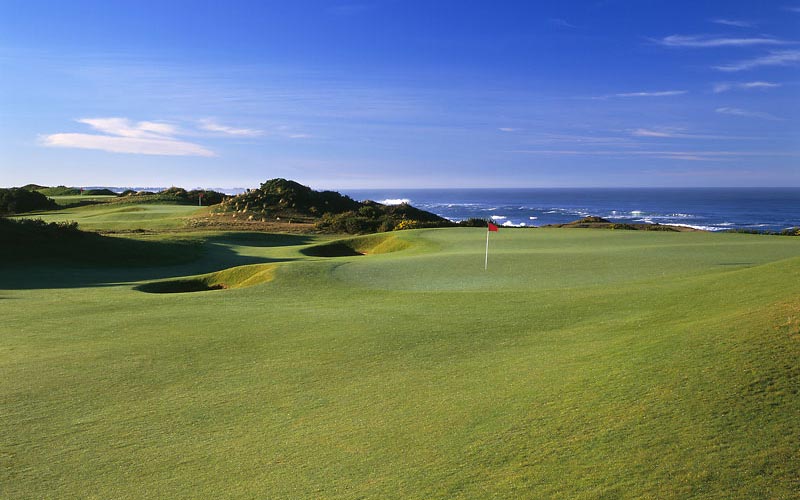
The awesome green site at the fourth hole allows for a run up shot.
Fifth hole, 445 yards; The fifth leaves one withmixed feelings about what is probably the most photographed hole at Bandon Dunes. The approach shot through the dunes is arguably the course’s finest. However, what is perplexing is how not enough room wascreated to the left of theislands of rough in the fairway. The player is simply not tempted to drive down that side (although doing so would provide for a better approach as the right side of the fairway offers a blind second). Since this is already a 445-yarder into the prevailing wind, the fifth should in theory have one of the wider fairways on the course, not one of the narrowest.David Kiddmaintains the islands were originally there so he merely left them. Still, if the left fairway were enlarged so as to be a real option, it would be an all-world.
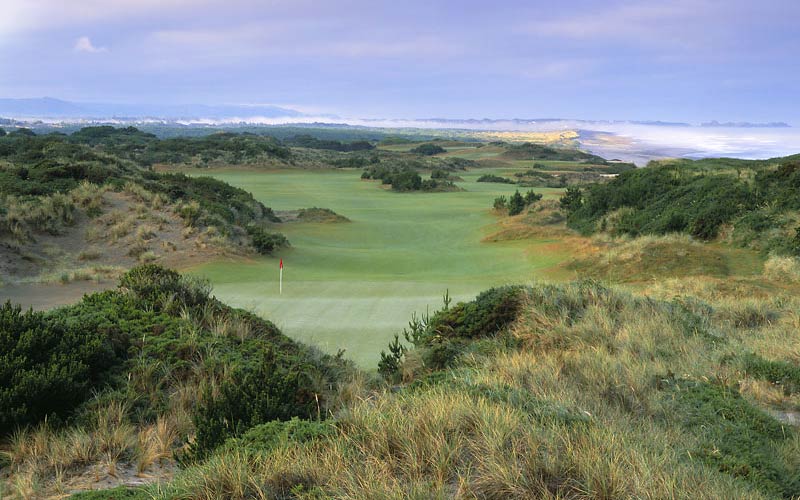
Looking back down the fifth, its green is nestled between the dunes and features a middle plateau that trisects it.
Seventh hole, 410 yards; Boasting a long time favourite ploy of Pete Dye and Tim Liddy, the tee ball favors a draw while the approach shot favors a fade. The green is one of the most boldly contoured and from its elevated perch, requires an exacting approach for a hole of its length. Architecturally, this is one of thefiner oneson the course though few people talk about it as it is removed from the cliffs.

As the golfer turns away from the coast, they are greeted with the interesting ‘switch back’ seventh.
Bandon Dunes
OR, USA
Eighth hole, 360 yards; A clever hole with five cross bunkers to contend with some 200 yards from the tee. The exceedingly wide fairway beyond encourages the player to open his shoulders. Now the architect has the player, for the approach is much easier from the right side – where there is a bunker – thanks to the slope off the front left greenside bunker. The eighth is a refreshing and original hole and itsback left hole location is one of the best hole locations of the resort’s fifty-four holes.
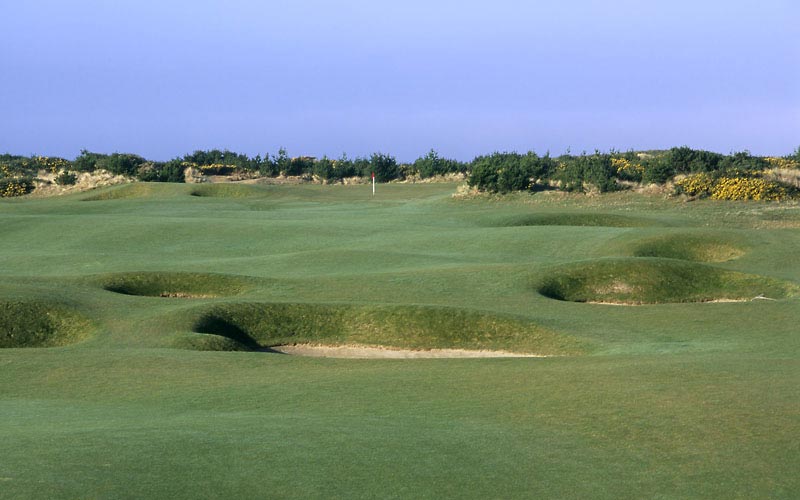
The challenge off the eighth tee is evident.
Tenth hole, 360 yards; The tenth has a wonderful golf quality that is too rarely seen, the kind of hole in that there is no one right way to play it.Though theocean holes get the attention for all the obvious reasons, the interior holes at Bandon Dunes best display Kidd’s talents. Though plenty of dirt was moved to create the 10th, a number of interesting angles are the worthwhile result. The best angle into the green is from theleft edge of the fairwaybut on the other hand,the shortest route to the green is straight ahead offthe tee. You decide, and the odds are that during your stay, you will experiment with the different approach angles into the green. The strategy is reminiscent of Riviera’s all-world 10th hole and anytime that is drawn on as inspiration, promising golf follows.
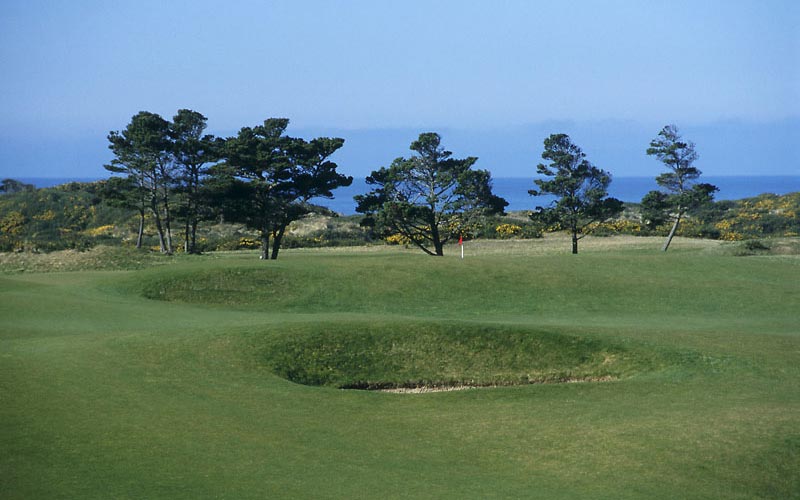
Kidd’s use of angles makes the tenth an intelligent short par four. As seen above, the shorter route leaves a blind approach.
Eleventh hole, 385 yards; With a bunkering scheme evocative of the 12th at Sunningdale Old, Kidd tries to lull the golfer to play to the right on both his tee ball and approach shot, and from either location,Kidd’s trap is sprung. There are a series of bunkers down the left hand side of the fairway and miles of room to the right but the angle from the right into the green is amiserable one as the right front greenside bunker must be contended with and the green is pitched from right to left and runs away from the player. The one bunker guarding the front-right corner of the green dominates the approach and the cautious player is tempted to play to the right where little trouble seems to lurk. Of course, once there, his flop pitch is desperately difficult as he must get it up on top of the ridge while stopping it on the green which runs away from him.
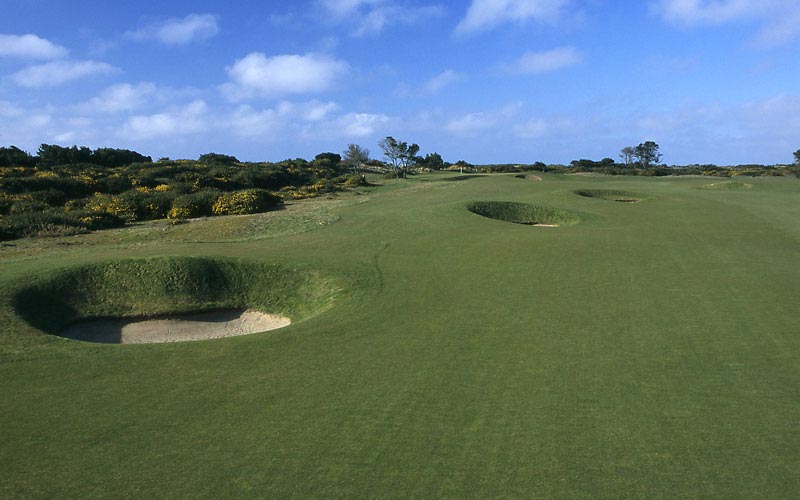
The closer the tee ball comes to these bunkers down the left of the eleventh fairway, the better one’s angle is into the right to left sloping green.
Twelfth hole, 200 yards; A good example of Scottish frugality, this time with bunkering. There is but one bunker here, but that is all the player sees, thanks to its steep revetted face. The green is similar to the Road Hole with both the angle of the green and the key bunker. The cliff makes an altogether satisfactory replacement for the hazard of the road, although it is not as close to the green.

As seen from the right, the single bunker dominates the play at the one shot twelfth.
Fourteenth hole, 360 yards; Kidd’s favorite hole and yet another appealing two shotter under 400 yards. A precise tee shot needs to carry a bunkersome 205 yards from the tee that is smack in the middle of the fairway while still staying short of or to the side of another fairway bunker at the 235 yard mark. On top of that, the hole plays into the prevailing wind. The angled green is tuckedagainst the hillside and offers the best approach from the left.
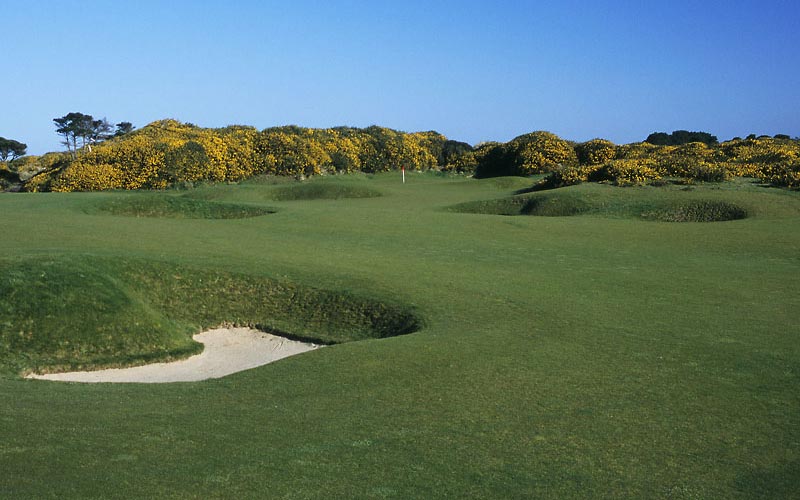
The attractive backdrop to the 14th green.
Fifteenth hole, 185 yards; As with the 11th and 12th, one bunker dominates the green.At 14 feet deep,this green side bunkeralso happens to be the deepest one on the course. The green sits on top of an exposed knob and offers no help whatsoever to those who miss the green. It would not be difficult to imagine the golfer having difficulty finding the green with their first shot, let alone their second. Great satisfaction follows a well struck shot, especially since the hole was furtherenhanced when the tee was moved twenty yards to the right during the winter of 2000/2001.
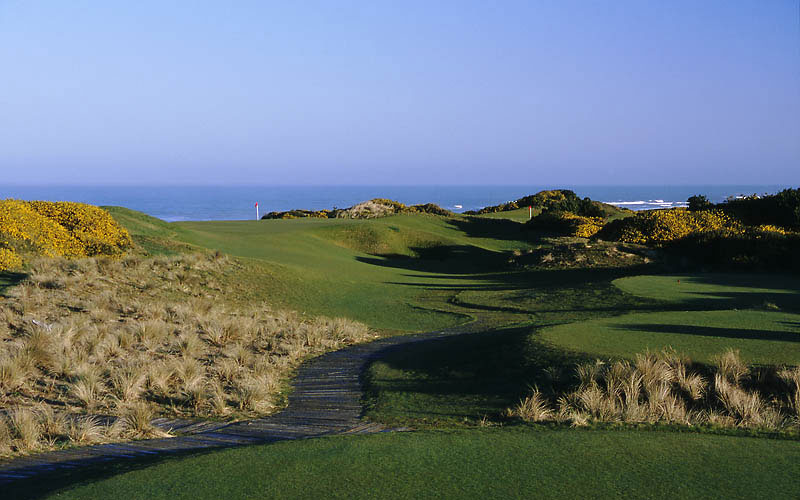
The difficult uphill 15th, with the challenging greenside bunker guarding the front right.
Sixteenth hole, 365 yards; A rarity, in the sense that the hole definitely plays better in a particular wind direction. In this case, that is downwind and there is simply no more thrilling shot at the resort than trying to drive the green with a favorable breeze helping. Watching a ball in line with the cliffside trying to navigate successfully to the green is a treat. Although a superb drive is required, the green is open from this angle and fairly receptive. Conversely, for the average golfer or if its into the wind, the second shot becomes the focus of the hole after a lay up off the tee to the fairway. The single pot bunker that is flush against the center of the green dictates the approach, depending on the angle of approach. The further towards the cliff the tee ball is played, the more open (but blind) the approach is. From the left side the golfer stares at the throat of the bunker and must decide whether their wedge play is sharp enough to try to carry the bunker to a middle or left pin, or play to the wide part of this large green. Once again, what the bunkers lack in size, they make up for in bite and can easily help ratchet up the score.
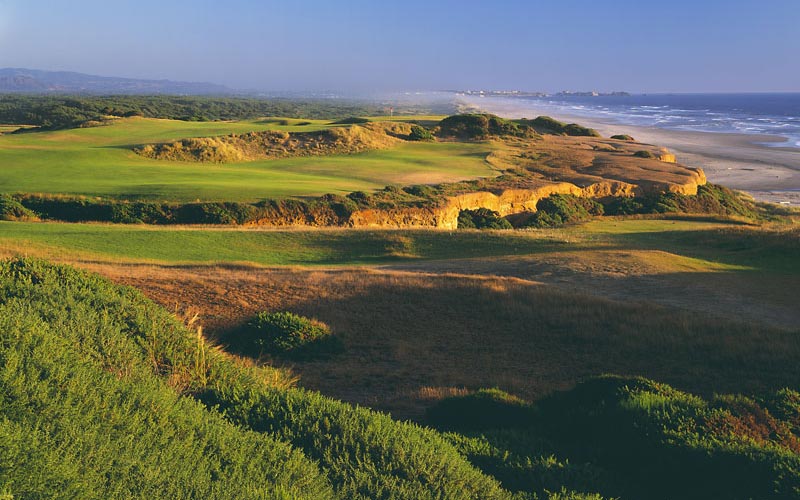
The stunning 16th hole, the golfers last taste of the Pacific.
In hindsight, Bandon Dunes faced a difficult task of maintaining its initial acclaim when golf’s top two architectural firms (Doak’s Renascence and Coore & Crenshaw) followed it with the second and third courses at the resort. For instance, Coore’s tremendous routing at Bandon Trails highlights some of the routing weakness at Bandon Dunes. Given that there was no real estate concerns and a relatively blank canvas, the golfer is faced with several regretable long tee to green walks at Bandon Dunes.More importantly, the starting and finishing pointsof thefirst, ninth andand eighteenthholesare the leastdistinctive holes on the course. Fortunately, Kidd continues to refineBandon Dunes(ironically, a sign that it wasn’t as good as everyone initially thought). In the winter of 2000/2001 alone, the second and sixth green complexes were grassed in and made more playable, the ninth and 15th tees were relocated totheir ideal locations, and the 17th fairway andits bunkering was dramaticallyenhanced downthe left hand side. Kidd’s ability to implement strategic golf holes and effective use of bunkers show the promise that lies ahead in a career that has already led him toseveral otherwonderful commissions throughout the world.
Golf Club Atlas wishes to acknowledge and thankWood Sabold for the use ofhis manyphotographs above.
The End

